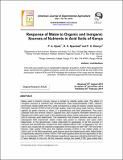| dc.description.abstract | Maize yield in Kericho County, Kenya is limited by infertile acidic soils. The effect of inorganic sources of nutrients and amendments; triple superphosphate (TSP), calcium ammonium nitrate (CAN) and lime, were compared to a range of organic nutrient sources; Farmyard manure (FYM) of low and high quality, dried cow dung, goat manure, tithonia applied as green manure or dried, in a greenhouse and field experiment. Two soils collected from two farmers’ fields in Sigowet and Litein locations (Hereafter referred to as Sigowet and Litein) were used in the greenhouse where maize was grown for six weeks and its biomass yield determined. The treatments that showed promise were used in a subsequent field experiment where maize was grown to maturity and grain yield determined. In the greenhouse, maize responded to application of all the sources of nutrients and amendments, except lime when applied without TSP, on Sigowet’s soil. On Litein’s soil, maize did not respond to application of lime alone or with TSP, TSP and dried tithonia. High quality FYM gave the highest increase (136%) in dry matter yields on Litein’s soil. In the field experiment, goat manure gave the highest grain yield. Maize failed to significantly respond to either CAN or TSP when applied alone but the application of the two in combination (TSP + CAN) effected a significant response indicating that both N and P were deficient in this soil. All the manures, except low quality FYM, gave yields that were higher or comparable to the standard recommended fertilizer practice (TSP + CAN) and could be economically attractive substitutes as they are locally available. There was a poor correlation between dry matter biomass yield in the greenhouse and grain yield in the field. Extrapolation of greenhouse findings to different fields should therefore be treated with caution | en_US |

